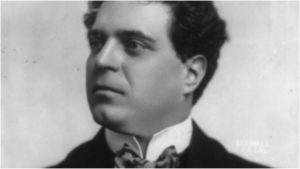
Not Just ‘Cavalleria Rusticana’ – A Survey of Pietro Mascagni’s Other Operas
By David SalazarWe all know “Cavalleria Rusticana,” the great masterpiece of Pietro Mascagni, who was born on Dec. 7, 1863.
Unfortunately, that’s all most people in the opera world and outside of it, know about the Italian composer. It’s actually quite unfortunate, given that “Cavalleria” was his very first opera and that he would go on to write 15 total, his final one comes 45 years after “Cavalleria Rusticana.”
And while some of his works, such as “Iris” and “L’Amico Fritz” got some great play over the years, the other 12 have simply vanished from the repertoire. For those unfamiliar with Mascagni’s overall oeuvre, this article is dedicated to you.
L’Amico Fritz
The composer’s second opera came out one year after ”Cavalleria Rusticana” and contains the famous Cherry duet that is often performed. The opera tells the story of a wealthy landowner who claims that he shall never marry. However, he falls in love with Suzel, the daughter of one of his tenants and eventually winds up winning her over by the end of the opera. It has been recorded by a number of major artists including Luciano Pavarotti, Mirella Freni, Roberto Alagna, and Angela Gheroghiu.
I Rantzau
The composer’s third opera has rarely been performed in modern times, though it possesses one duet that has piqued the interest of the likes of Plácido Domingo and Renata Scotto. There is but one full recording of the entire opera.
Guglielmo Ratcliff
This is the work that the composer considered his finest, though it never quite established any foothold in the repertoire. It features a challenging tenor role and has obtained a few performances at both the Wexford Festival Opera and Alice Tully Hall in the 21st century.
Silvano
Best known as the “other” Mascagni piece in Martin Scorcese’s “Raging Bull” (the other of course being the famed Intermezzo from “Cavalleria Rusticana”), the composer’s fifth opera shows great musical development from the composer.
Zanetto
The sixth opera of Mascagni is a return to his one-act opera, as exhibited with “Cavalleria.” The opera is set in the renaissance and showcases the encounter between a courtesan and wandering minstrel, Zanetto.
Iris
The other well-known Mascagni opera is set in Japan during legendary times and relates the story of a young girl who is carried off by a libertine. When she doesn’t acquiesce to his advances he abandons her to her fate, her father shames her, and she winds up committing suicide.
Le Maschere
The story of the composer’s eighth opera is quite fascinating as it made its premiere at six houses on the same exact day including Teatro Carlo Felice, Teatro Regio, Teatro alla Scala, Teatro La Fenice, Teatro Filarmonico, and Teatro Costanzi. But things didn’t go well for the work as its premiere in Genoa was stopped halfway through due to raucous behavior from the audience. The work is a play within a play.
Amica
Mascagni’s ninth opera is his only French one and is very much in the verismo vein. It tells the tragic tale of two brothers and the woman they love.
Isabeau
This opera had its first premiere in Argentina and is a retelling of the medieval legend of Lady Godiva. King Raimondo makes his daughter Isabeau ride naked around the city with a law demanding that she not be looked upon. When an unsuspecting falconer Folco accidently does, he is thrown in prison and ultimately killed. Isabeau kills herself as well.
Parisina
One of the composer’s longest operas, its length wound up being one of the major problems that essentially cut short its artistic hope. There is a three-act version, though its fourth act contains its best music.
Lodoletta
While the work made its world premiere in Rome, its more famous premiere took place a year later at the Metropolitan Opera with Geraldine Farrar in the title role and Enrico Caruso as Flammen.
Il Piccolo Marat, Pinotta, Nerone
The composer’s final three operas haven’t really had much of an impact since their respective premieres though they have received rare recordings here and there.
Which of Mascagni’s rare operas is your favorite? Tell us in the comments below!


